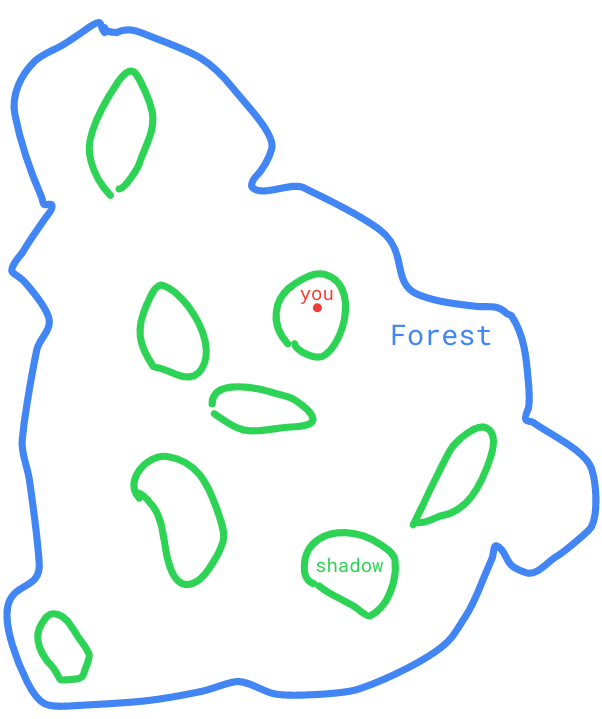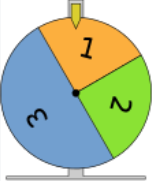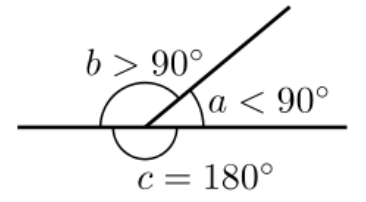Examples of Measures
post by Maxwell Peterson (maxwell-peterson) · 2020-11-15T01:44:39.593Z · LW · GW · 20 commentsContents
The count measure The Dirac measure The Lebesgue measure Probability measure Angle measure None 20 comments
I recently started learning measure theory but had a pretty hard time finding real-world examples of the different measures. So this is a list of real-world examples of some different, common measures.
The count measure
If I have 4 apples, their count measure is 4. The count measure is just normal counting.
The Dirac measure
You are camping in a forest with some trees. You've set up your tent and it was a lot of work, so you're not going to move. It's daytime. The trees cast shadows, but the tree cover is sparse enough that there's still some sunlight that hits the ground. As the day goes on, the shadows move, at times covering your camp, at times leaving you in the sun. The dirac measure for whether a shadow is on your tent is something that outputs 1 when a shadow is on your tent, and 0 when there isn't a shadow on your tent.

Formally, if means "Tent is in shadow", and A is the collection of shadow regions, the mathematical expression of this dirac measure is
The dirac measure always looks like this, whatever meanings you attach to and the set A.
(Since x is a point, the analogy breaks down a little: shadows are not allowed to partially overlap the tent. They cover it fully, or they don't touch it. We could fix this above by talking about "the northwesternmost atom of fabric of the tent" instead of "the tent").
(The dirac measure is similar to the indicator function (not measure!) , which takes a point and returns whether or not it's in A. For example, if you were walking around the forest instead of entented in it - that is, if the red point in the picture was moving around and the shadows didn't move, instead of the other way around - you could set up an indicator function to be 1 when you're inside a shadow, and 0 when you're outside one. A previous version of this post confused the dirac measure with the indicator function; the difference is that takes a set A as input and assumes fixed, while takes a point as input and assumes the set A fixed. Thanks to deluks917 in the comments for the correction.)
The Lebesgue measure
The length of a line. The area of a flat shape. The volume of a 3D object. The equivalent concept in 4D, 5D, and so on. The name can be intimidating, but as a person in the physical world, you already have an intuitive idea of how the Lebesgue measure should work.
An important feature of the Lebesgue measure is that if you move your set around, doesn't change. An orange has the same volume whether it's in my left hand, my right hand, or balanced on your head across the room from me. Also known as "translation invariance".
So far as I can tell, the Jordan measure and Borel measure are very similar to the Lebesgue measure, and as such I struggle to find real-world examples of them that explain how they are different from the Lebesgue. If someone puts intuitive examples of these in the comments, I’ll add them to this post.
Probability measure
A probability measure is a measure that satisfies the usual requirements on a probability distribution: it's restricted to the range (0, 1), its sum over that range is 1, and it satisfies a condition called "countable additivity", which you probably don't have to think about too much.
Pictured is an example with

Angle measure
A measure that sums to 360°. Pictured, .

Angle measures are rotation invariant: rotate the picture above, and a, b, and c will still be the same angles. I think they're translation invariant, too? Seems like if you scoot that picture around, nothing changes, as long as you moved everything all at the same time.
There are more measures, but I don't understand them yet!
Thanks to the Youtube channel The Bright Side Of Mathematics for getting me from knowing nothing to knowing something, when all the other expositions I found were too hard to understand.
20 comments
Comments sorted by top scores.
comment by Steven Byrnes (steve2152) · 2020-11-15T16:28:26.358Z · LW(p) · GW(p)
It's spelled Lebesgue (and pronounced "luh BEG" I think). :-)
Replies from: maxwell-peterson↑ comment by Maxwell Peterson (maxwell-peterson) · 2020-11-15T16:38:20.787Z · LW(p) · GW(p)
Fixed!
comment by gjm · 2020-11-15T16:31:22.948Z · LW(p) · GW(p)
Nitpick: Lebesgue with a G, not Lebesque with a Q.
Replies from: maxwell-peterson↑ comment by Maxwell Peterson (maxwell-peterson) · 2020-11-15T16:37:48.441Z · LW(p) · GW(p)
Thanks - fixed
comment by adamShimi · 2020-11-16T20:51:30.012Z · LW(p) · GW(p)
Cool post! I like this both because finding examples is the best way to work out what a definition constrains and captures, and also because I'm studying a bit of measure theory too.
So far as I can tell, the Jordan measure and Borel measure are very similar to the Lebesgue measure, and as such I struggle to find real-world examples of them that explain how they are different from the Lebesgue. If someone puts intuitive examples of these in the comments, I’ll add them to this post.
Checking quickly on Wikipedia, it seems that the Borel measure is literally the same as the Lebesgue measure, but defined on a smaller -algebra (the Borel -algebra instead of the Lebesgue -algebra, see here). As for the Jordan "measure", it is apparently a precursor of the Lebesgue measure, and is not a true measure as it's not defined on a -algebra (see here). The difference is that the Jordan "measure" is only defined on sets with boundary of Lebesgue/Jordan measure 0, which is not the case for the Lebesgue measure apparently.
All that to say, not having examples of Borel and Jordan measure is not an issue, as these would apparently be limited Lebesgue measures anyway.
Replies from: maxwell-peterson↑ comment by Maxwell Peterson (maxwell-peterson) · 2020-11-17T01:26:12.059Z · LW(p) · GW(p)
Thanks!
That helps - I wasn't sure whether there might maybe be some small special intuitive difference in Borel or Jordan that could correspond to a different real world example, but now I think that's definitely a No.
comment by alahonua · 2020-11-15T19:20:40.796Z · LW(p) · GW(p)
Read this online classic paper about geometric measure theory, because it's really entertaining:
https://www.maths.ed.ac.uk/~tl/docs/Schanuel_Length_of_potato.pdf
Replies from: maxwell-peterson↑ comment by Maxwell Peterson (maxwell-peterson) · 2020-11-16T00:32:46.310Z · LW(p) · GW(p)
Nice recommendation - learned multiple things from it
comment by Donald Hobson (donald-hobson) · 2020-11-15T09:25:41.265Z · LW(p) · GW(p)
There is the cantor distribution.
https://en.wikipedia.org/wiki/Cantor_distribution
One way of getting it is to take a coin, write 0 on one side and 2 on the other. Flip it infinity times. This gives you a number in trinary.
If you have a set to measure, then where is the number made in trinary above.
There are also measurable cardinals. https://en.wikipedia.org/wiki/Measurable_cardinal
These are cardinals big enough to have a 0,1 measure on their powerset.
Well ZFC can't prove whether or not they exist. If you know what ultra-filters are, these are ulrafilters that meet the stronger condition of being closed under countable intersection, not just finite intersection.
comment by sapphire (deluks917) · 2020-11-16T03:07:19.457Z · LW(p) · GW(p)
Something about your explanation of the Dirac measure feels off to me. "The dirac measure for whether you're standing in a shadow is something that outputs 1 when you're standing in a shadow, and 0 if you're not." What you seem to be describing is the indicator function of the shadowed region bounded in green. A measure takes a set as an input, not a point.
Maybe I am the one misunderstanding. But at the very least you are explaining the direct measure in a non-standard way. The way I think of the Dirac measure is that all the 'mass' is concentrated at a single point. This is not the same as an indicator function.
Indicator_function (point) = 1 iff the point is in the set
Direct_measure (set) = 1 iff the set contains the special point
Replies from: maxwell-peterson↑ comment by Maxwell Peterson (maxwell-peterson) · 2020-11-16T04:08:47.960Z · LW(p) · GW(p)
Ahh. I could very well be wrong. Trying to understand this; visualization-wise, are you saying that instead of visualizing the point moving around, with the green circles fixed, we should be visualizing the green circles moving around, with the point fixed?
Replies from: deluks917, deluks917↑ comment by sapphire (deluks917) · 2020-11-16T05:58:14.098Z · LW(p) · GW(p)
Alternate explanation:
dirac_x(A) is a function of A, x is fixed.
Replies from: maxwell-peterson↑ comment by Maxwell Peterson (maxwell-peterson) · 2020-11-16T06:01:32.130Z · LW(p) · GW(p)
Yeah, this makes sense. Hmm. I’ll think about this more then edit the post. Thanks
↑ comment by sapphire (deluks917) · 2020-11-16T05:35:04.136Z · LW(p) · GW(p)
Since this is lesswrong let me try to explain with probability.
If you have a random variable X then you have an associated measure:
measure(A) = probability that X is in A.
If X has a probability density function f then:
measure(A) = integral over A of f = probability that X is in A
If you measure has an associated density then you can visualize it by visualizing the probability density function.
You get the Dirac measure if X is constant. Your random variable X always returns the same result. The associated pdf is the Dirac delta 'function'. Sometimes people visualize the Dirac delta as an infinitely tall and infinitely thin Gaussian.
Does this make sense?
comment by lsusr · 2020-11-15T07:26:06.854Z · LW(p) · GW(p)
Here are a few more measures.
Integral measure
Let be two continuous functions defined on the interval . The integral of the absolute value of their difference is a measure.
Equality measure
Let be any two mathematical objects. The equality measure equals 0 if . Otherwise the equality measure equals 1. (This is equivalent to the side lengths of an -dimensional tetrahedron.)
Cartesian measure
Let be two measures defined on sets , respectively.
- The measure defined on set is a measure.
- If then is a measure on .
Applying the Cartesian measure to Lebesgue measure gives us taxicab distance. Let . Taxicab distance is a measure.
Replies from: DanielFilan↑ comment by DanielFilan · 2020-11-15T07:38:50.312Z · LW(p) · GW(p)
I think you might be confusing measures with metrics.
Replies from: Pattern, lsusr↑ comment by Pattern · 2020-11-16T18:23:53.356Z · LW(p) · GW(p)
What's the difference?
Replies from: maxwell-peterson, DanielFilan↑ comment by Maxwell Peterson (maxwell-peterson) · 2020-11-16T19:11:17.684Z · LW(p) · GW(p)
Intuitively, a metric outputs how different two things are, while a measure outputs how big something is.
In terms of inputs and outputs: a metric takes two points as input, and outputs a positive real number. A measure takes one set as input, and outputs a positive real number.
↑ comment by DanielFilan · 2020-11-17T21:21:16.111Z · LW(p) · GW(p)
A metric gives the 'distance' between two points, while a measure gives the 'weight' of a subset (quotes are scare quotes).